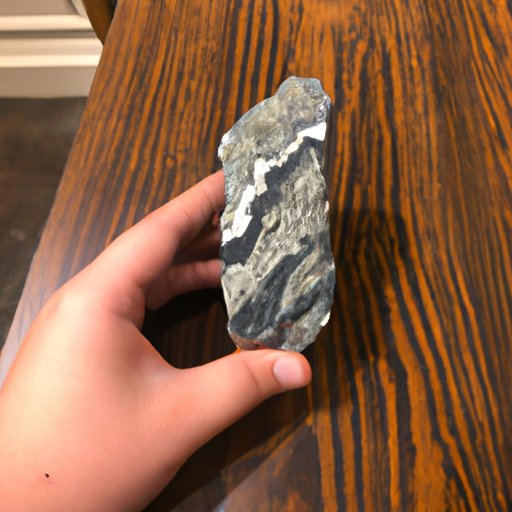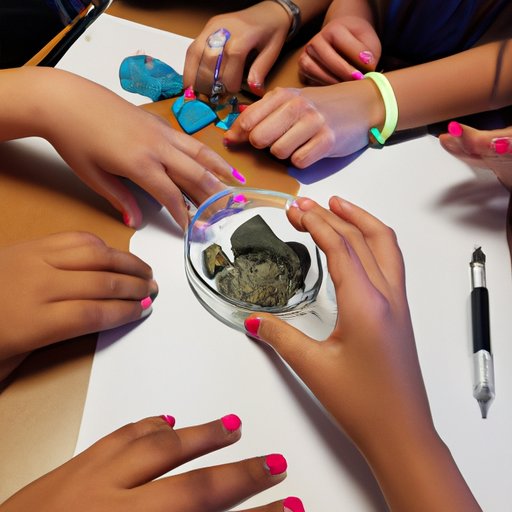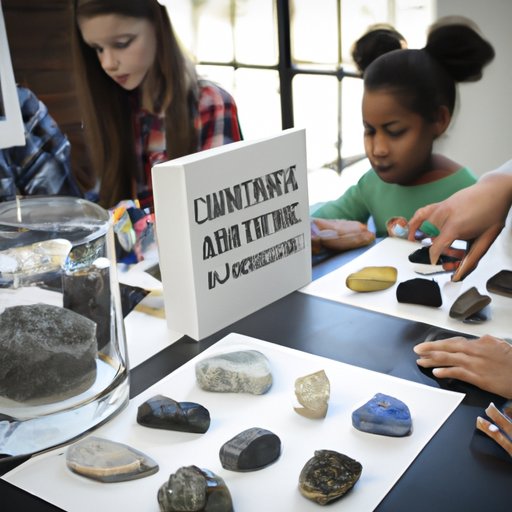Introduction
Rocks and minerals are two of the most important components of the Earth’s crust. Rocks are made up of one or more minerals and can be classified into three main categories: igneous, sedimentary and metamorphic. Minerals on the other hand are naturally occurring solids with a definite chemical composition and ordered internal structure. They are essential for life and are used for various purposes such as construction, medicine, and jewelry.

Exploring the Geology of Rocks and Minerals
The types of rocks and minerals that make up the Earth’s crust vary greatly depending on their location and geological processes. Igneous rocks form when molten rock cools and solidifies, while sedimentary rocks are formed from the accumulation of sediments over time. Metamorphic rocks are created when existing rocks are exposed to high temperatures and pressures. Each type of rock contains different minerals, and the minerals within each rock have a variety of shapes, sizes and colors.
Geological processes like weathering, erosion, and deposition play an important role in the formation of rocks and minerals. Weathering involves breaking down rocks into smaller pieces, while erosion transports the materials away. Deposition occurs when these materials settle and accumulate in new locations. These three processes work together to create the vast diversity of rocks and minerals found on the planet.
The Science Behind the Relationship Between Rocks and Minerals
The relationship between rocks and minerals is based on their chemical composition and physical properties. The chemical composition of rocks and minerals varies greatly and is determined by the elements that make up the mineral. Common elements found in rocks and minerals include oxygen, silicon, magnesium, and iron. Each element has its own unique chemical and physical properties, which determine the type of rock or mineral it forms.
Physical properties of rocks and minerals include hardness, color, luster, and cleavage. Hardness refers to the resistance of a material to being scratched or broken, while color describes the hue of the material. Luster describes the way light reflects off of the surface of the material, and cleavage determines the way the material breaks apart when force is applied. These physical properties help to identify different types of rocks and minerals.

Investigating How Rocks and Minerals Form
The formation of rocks and minerals is closely linked to the theory of plate tectonics. Plate tectonics is the study of the movement of the Earth’s lithospheric plates, which are large sections of the Earth’s outer layer. The movement of these plates causes pressure and heat to build up, resulting in the production of molten rock. This molten rock cools and solidifies to form igneous rocks, which contain various minerals.
Igneous rocks can also be altered by sedimentary and metamorphic processes. Sedimentary rocks are created when sediments from existing rocks are eroded, transported and deposited in new locations. Metamorphic rocks form when existing rocks are subjected to extreme temperatures and pressures. Both of these processes can change the chemical and physical properties of rocks and minerals, creating new and unique types of rocks and minerals.
Examining the Uses of Rocks and Minerals
Rocks and minerals are essential for many industries and are used in a variety of ways. For example, rocks and minerals are used in the construction industry to create buildings, roads, and bridges. They are also used in the manufacturing of products such as glass, ceramics, and paper. In addition, rocks and minerals are used in the medical field to produce medicines and treatments.
Rocks and minerals are also important natural resources. Coal, oil, and natural gas are all derived from rocks and minerals, and are used as sources of energy. Precious metals and gems, such as gold and diamonds, are also found in rocks and minerals. These resources are essential for many industries and are necessary for the continued development and growth of our society.

Understanding the Different Types of Rocks and Minerals
Rocks and minerals can be classified into various systems based on their characteristics. The most common system is the Mohs scale of hardness, which ranks minerals from 1 (softest) to 10 (hardest). Other classification systems include the Dana system, which categorizes minerals according to their chemical composition, and the Strunz system, which classifies minerals according to their crystalline structure.
Common examples of rocks and minerals include quartz, feldspar, mica, calcite, and pyrite. Quartz is a common mineral found in igneous, sedimentary and metamorphic rocks, while feldspar is found in igneous rocks. Mica is a soft mineral found in both igneous and metamorphic rocks, while calcite is a carbonate mineral found in sedimentary rocks. Pyrite, also known as fool’s gold, is a common mineral found in igneous and sedimentary rocks.
Conclusion
Rocks and minerals are two of the most important components of the Earth’s crust. They form through various geological processes and have distinct chemical and physical properties. Rocks and minerals are used in a variety of ways, from construction to medicine to natural resources. Understanding the relationship between rocks and minerals is essential for appreciating the complexity of the Earth’s geology and for recognizing the importance of these materials in our everyday lives.
(Note: Is this article not meeting your expectations? Do you have knowledge or insights to share? Unlock new opportunities and expand your reach by joining our authors team. Click Registration to join us and share your expertise with our readers.)
